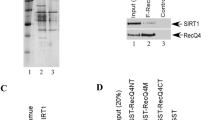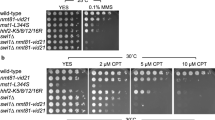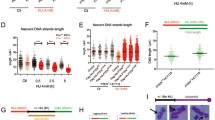Abstract
PIF1 family helicases are evolutionarily conserved among prokaryotes and eukaryotes. These enzymes function to support genome integrity by participating in multiple DNA transactions that can be broadly grouped into DNA replication, DNA repair, and telomere maintenance roles. However, the levels of PIF1 activity in cells must be carefully controlled, as Pif1 over-expression in Saccharomyces cerevisiae is toxic, and knockdown or over-expression of human PIF1 (hPIF1) supports cancer cell growth. This suggests that PIF1 family helicases must be subject to tight regulation in vivo to direct their activities to where and when they are needed, as well as to maintain those activities at proper homeostatic levels. Previous work shows that C-terminal phosphorylation of S. cerevisiae Pif1 regulates its telomere maintenance activity, and we recently identified that Pif1 is also regulated by lysine acetylation. The over-expression toxicity of Pif1 was exacerbated in cells lacking the Rpd3 lysine deacetylase, but mutation of the NuA4 lysine acetyltransferase subunit Esa1 ameliorated this toxicity. Using recombinant proteins, we found that acetylation stimulated the DNA binding affinity, ATPase activity, and DNA unwinding activities of Pif1. All three domains of the helicase were targets of acetylation in vitro, and multiple lines of evidence suggest that acetylation drives a conformational change in the N-terminal domain of Pif1 that impacts this stimulation. It is currently unclear what triggers lysine acetylation of Pif1 and how this modification impacts the many in vivo functions of the helicase, but future work promises to shed light on how this protein is tightly regulated within the cell.

Similar content being viewed by others
Availability of data and material
Not applicable.
References
Andis NM, Sausen CW, Alladin A, Bochman ML (2018) The WYL domain of the PIF1 helicase from the thermophilic bacterium Thermotoga elfii is an accessory single-stranded DNA binding module. Biochemistry 57:1108–1118. https://doi.org/10.1021/acs.biochem.7b01233
Appanah R, Jones D, Falquet B, Rass U (2020) Limiting homologous recombination at stalled replication forks is essential for cell viability: DNA2 to the rescue. Curr Genet. https://doi.org/10.1007/s00294-020-01106-7
Ayyagari R, Gomes XV, Gordenin DA, Burgers PM (2003) Okazaki fragment maturation in yeast. I. Distribution of functions between FEN1 AND DNA2. J Biol Chem 278:1618–1625. https://doi.org/10.1074/jbc.M209801200
Bah A, Forman-Kay JD (2016) Modulation of intrinsically disordered protein function by post-translational modifications. J Biol Chem 291:6696–6705. https://doi.org/10.1074/jbc.R115.695056
Balakrishnan L, Stewart J, Polaczek P, Campbell JL, Bambara RA (2010) Acetylation of Dna2 endonuclease/helicase and flap endonuclease 1 by p300 promotes DNA stability by creating long flap intermediates. J Biol Chem 285:4398–4404. https://doi.org/10.1074/jbc.M109.086397
Bannwarth S, Berg-Alonso L, Auge G, Fragaki K, Kolesar JE, Lespinasse F, Lacas-Gervais S, Burel-Vandenbos F, Villa E, Belmonte F, Michiels JF, Ricci JE, Gherardi R, Harrington L, Kaufman BA, Paquis-Flucklinger V (2016) Inactivation of Pif1 helicase causes a mitochondrial myopathy in mice. Mitochondrion 30:126–137. https://doi.org/10.1016/j.mito.2016.02.005
Bartos JD, Willmott LJ, Binz SK, Wold MS, Bambara RA (2008) Catalysis of strand annealing by replication protein A derives from its strand melting properties. J Biol Chem 283:21758–21768. https://doi.org/10.1074/jbc.M800856200
Belmonte FR, Dedousis N, Sipula I, Desai NA, Singhi AD, Chu Y, Zhang Y, Bannwarth S, Paquis-Flucklinger V, Harrington L, Shiva S, Jurczak MJ, O’Doherty RM, Kaufman BA (2019) Petite Integration Factor 1 (PIF1) helicase deficiency increases weight gain in Western diet-fed female mice without increased inflammatory markers or decreased glucose clearance. PLoS ONE 14:e0203101. https://doi.org/10.1371/journal.pone.0203101
Bochman ML, Judge CP, Zakian VA (2011) The Pif1 family in prokaryotes: what are our helicases doing in your bacteria? Mol Biol Cell 22:1955–1959. https://doi.org/10.1091/mbc.E11-01-0045
Bochman ML, Paeschke K, Chan A, Zakian VA (2014) Hrq1, a homolog of the human RecQ4 helicase, acts catalytically and structurally to promote genome integrity. Cell Rep 6:346–356. https://doi.org/10.1016/j.celrep.2013.12.037
Bochman ML, Sabouri N, Zakian VA (2010) Unwinding the functions of the Pif1 family helicases. DNA Repair (Amst) 9:237–249. https://doi.org/10.1016/j.dnarep.2010.01.008
Boule JB, Vega LR, Zakian VA (2005) The yeast Pif1p helicase removes telomerase from telomeric DNA. Nature 438:57–61. https://doi.org/10.1038/nature04091
Boule JB, Zakian VA (2007) The yeast Pif1p DNA helicase preferentially unwinds RNA DNA substrates. Nucleic Acids Res 35:5809–5818
Budd ME, Reis CC, Smith S, Myung K, Campbell JL (2006) Evidence suggesting that Pif1 helicase functions in DNA replication with the Dna2 helicase/nuclease and DNA polymerase delta. Mol Cell Biol 26:2490–2500. https://doi.org/10.1128/MCB.26.7.2490-2500.2006
Buzovetsky O, Kwon Y, Pham NT, Kim C, Ira G, Sung P, Xiong Y (2017) Role of the Pif1-PCNA complex in Pol delta-dependent strand displacement DNA synthesis and break-induced replication. Cell Rep 21:1707–1714. https://doi.org/10.1016/j.celrep.2017.10.079
Chen B, Hua Z, Gong B, Tan X, Zhang S, Li Q, Chen Y, Zhang J, Li Z (2020) Downregulation of PIF1, a potential new target of MYCN, induces apoptosis and inhibits cell migration in neuroblastoma cells. Life Sci 256:117820. https://doi.org/10.1016/j.lfs.2020.117820
Chen WF, Dai YX, Duan XL, Liu NN, Shi W, Li N, Li M, Dou SX, Dong YH, Rety S, Xi XG (2016) Crystal structures of the BsPif1 helicase reveal that a major movement of the 2B SH3 domain is required for DNA unwinding. Nucleic Acids Res 44:2949–2961. https://doi.org/10.1093/nar/gkw033
Chib S, Byrd AK, Raney KD (2016) Yeast helicase Pif1 unwinds RNA:DNA hybrids with higher processivity than DNA:DNA duplexes. J Biol Chem 291:5889–5901. https://doi.org/10.1074/jbc.M115.688648
Chisholm KM, Aubert SD, Freese KP, Zakian VA, King MC, Welcsh PL (2012) A genomewide screen for suppressors of Alu-mediated rearrangements reveals a role for PIF1. PLoS ONE 7:10. https://doi.org/10.1371/journal.pone.0030748
Dahan D, Tsirkas I, Dovrat D, Sparks MA, Singh SP, Galletto R, Aharoni A (2018) Pif1 is essential for efficient replisome progression through lagging strand G-quadruplex DNA secondary structures. Nucleic Acids Res 46:11847–11857. https://doi.org/10.1093/nar/gky1065
Deegan TD, Baxter J, Ortiz Bazan MA, Yeeles JTP, Labib KPM (2019) Pif1-family helicases support fork convergence during DNA replication termination in eukaryotes. Mol Cell 74(231–244):e239. https://doi.org/10.1016/j.molcel.2019.01.040
Dehghani-Tafti S, Levdikov V, Antson AA, Bax B, Sanders CM (2019) Structural and functional analysis of the nucleotide and DNA binding activities of the human PIF1 helicase. Nucleic Acids Res 47:3208–3222. https://doi.org/10.1093/nar/gkz028
Falquet B, Olmezer G, Enkner F, Klein D, Challa K, Appanah R, Gasser SM, Rass U (2020) Disease-associated DNA2 nuclease-helicase protects cells from lethal chromosome under-replication. Nucleic Acids Res 48:7265–7278. https://doi.org/10.1093/nar/gkaa524
Fong JH, Shoemaker BA, Garbuzynskiy SO, Lobanov MY, Galzitskaya OV, Panchenko AR (2009) Intrinsic disorder in protein interactions: insights from a comprehensive structural analysis. PLoS Comput Biol 5:e1000316. https://doi.org/10.1371/journal.pcbi.1000316
Foury F, Kolodynski J (1983) pif mutation blocks recombination between mitochondrial rho+ and rho- genomes having tandemly arrayed repeat units in Saccharomyces cerevisiae. Proc Natl Acad Sci 80:5345–5349
Gagou ME, Ganesh A, Phear G, Robinson D, Petermann E, Cox A, Meuth M (2014) Human PIF1 helicase supports DNA replication and cell growth under oncogenic-stress. Oncotarget 5:11381–11398
Gagou ME, Ganesh A, Thompson R, Phear G, Sanders C, Meuth M (2011) Suppression of apoptosis by PIF1 helicase in human tumor cells. Can Res 71:4998–5008. https://doi.org/10.1158/0008-5472.can-10-4404
George T, Wen Q, Griffiths R, Ganesh A, Meuth M, Sanders CM (2009) Human Pif1 helicase unwinds synthetic DNA structures resembling stalled DNA replication forks. Nucleic Acids Res 37:6491–6502. https://doi.org/10.1093/nar/gkp671
Ivessa AS, Zhou JQ, Zakian VA (2000) The Saccharomyces Pif1p DNA helicase and the highly related Rrm3p have opposite effects on replication fork progression in ribosomal DNA. Cell 100:479–489. https://doi.org/10.1016/s0092-8674(00)80683-2
Kahli M, Osmundson JS, Yeung R, Smith DJ (2019) Processing of eukaryotic Okazaki fragments by redundant nucleases can be uncoupled from ongoing DNA replication in vivo. Nucleic Acids Res 47:1814–1822. https://doi.org/10.1093/nar/gky1242
Kato M, Han TW, Xie S, Shi K, Du X, Wu LC, Mirzaei H, Goldsmith EJ, Longgood J, Pei J, Grishin NV, Frantz DE, Schneider JW, Chen S, Li L, Sawaya MR, Eisenberg D, Tycko R, McKnight SL (2012) Cell-free formation of RNA granules: low complexity sequence domains form dynamic fibers within hydrogels. Cell 149:753–767. https://doi.org/10.1016/j.cell.2012.04.017
Kettenbach AN, Schweppe DK, Faherty BK, Pechenick D, Pletnev AA, Gerber SA (2011) Quantitative phosphoproteomics identifies substrates and functional modules of Aurora and Polo-like kinase activities in mitotic cells. Sci Signal. https://doi.org/10.1126/scisignal.2001497
Kobayashi T (2003) The replication fork barrier site forms a unique structure with Fob1p and inhibits the replication fork. Mol Cell Biol 23:9178–9188. https://doi.org/10.1128/mcb.23.24.9178-9188.2003
Kobayashi T, Horiuchi T (1996) A yeast gene product, Fob1 protein, required for both replication fork blocking and recombinational hotspot activities. Genes Cells 1:465–474. https://doi.org/10.1046/j.1365-2443.1996.d01-256.x
Koc KN, Singh SP, Stodola JL, Burgers PM, Galletto R (2016) Pif1 removes a Rap1-dependent barrier to the strand displacement activity of DNA polymerase delta. Nucleic Acids Res 44:3811–3819. https://doi.org/10.1093/nar/gkw181
Lahaye A, Leterme S, Foury F (1993) PIF1 DNA helicase from Saccharomyces cerevisiae. Biochemical characterization of the enzyme. J Biol Chem 268:26155–26161
Lahaye A, Stahl H, Thines-Sempoux D, Foury F (1991) PIF1: a DNA helicase in yeast mitochondria. EMBO J 10:997–1007
Lerner LK, Sale JE (2019) Replication of G Quadruplex DNA. Genes (Basel). https://doi.org/10.3390/genes10020095
Liu JQ, Chen CY, Xue Y, Hao YH, Tan Z (2010) G-quadruplex hinders translocation of BLM helicase on DNA: a real-time fluorescence spectroscopic unwinding study and comparison with duplex substrates. J Am Chem Soc 132:10521–10527. https://doi.org/10.1021/ja1038165
Lozada E, Yi J, Luo J, Orren DK (2014) Acetylation of Werner syndrome protein (WRN): relationships with DNA damage, DNA replication and DNA metabolic activities. Biogerontology 15:347–366. https://doi.org/10.1007/s10522-014-9506-3
Lu KY, Chen WF, Rety S, Liu NN, Wu WQ, Dai YX, Li D, Ma HY, Dou SX, Xi XG (2018) Insights into the structural and mechanistic basis of multifunctional S. cerevisiae Pif1p helicase. Nucleic Acids Res 46:1486–1500. https://doi.org/10.1093/nar/gkx1217
Luo J, Solimini NL, Elledge SJ (2009) Principles of cancer therapy: oncogene and non-oncogene addiction. Cell 136:823–837. https://doi.org/10.1016/j.cell.2009.02.024
Makovets S, Blackburn EH (2009) DNA damage signalling prevents deleterious telomere addition at DNA breaks. Nat Cell Biol 11:1383–1386. https://doi.org/10.1038/ncb1985
Malkova A, Ira G (2013) Break-induced replication: functions and molecular mechanism. Curr Opin Genet Dev 23:271–279. https://doi.org/10.1016/j.gde.2013.05.007
Mohammad JB, Wallgren M, Sabouri N (2018) The Pif1 signature motif of Pfh1 is necessary for both protein displacement and helicase unwinding activities, but is dispensable for strand-annealing activity. Nucleic Acids Res 46:8516–8531. https://doi.org/10.1093/nar/gky654
Muellner J, Schmidt KH (2020) Yeast Genome Maintenance by the Multifunctional PIF1 DNA Helicase Family. Genes (Basel). https://doi.org/10.3390/genes11020224
Muftuoglu M, Kusumoto R, Speina E, Beck G, Cheng WH, Bohr VA (2008) Acetylation regulates WRN catalytic activities and affects base excision DNA repair. PLoS ONE 3:e1918. https://doi.org/10.1371/journal.pone.0001918
Nickens DG, Rogers CM, Bochman ML (2018) The Saccharomyces cerevisiae Hrq1 and Pif1 DNA helicases synergistically modulate telomerase activity in vitro. J Biol Chem 293:14481–14496. https://doi.org/10.1074/jbc.RA118.004092
Nickens DG, Sausen CW, Bochman ML (2019) The Biochemical Activities of the Saccharomyces cerevisiae Pif1 Helicase Are Regulated by Its N-Terminal Domain. Genes (Basel). https://doi.org/10.3390/genes10060411
Ononye OE, Sausen CW, Balakrishnan L, Bochman ML (2020) Lysine Acetylation Regulates the Activity of Nuclear Pif1. J Biol Chem. https://doi.org/10.1074/jbc.RA120.015164
Paeschke K, Bochman ML, Garcia PD, Cejka P, Friedman KL, Kowalczykowski SC, Zakian VA (2013) Pif1 family helicases suppress genome instability at G-quadruplex motifs. Nature 497:458–462. https://doi.org/10.1038/nature12149
Paeschke K, Capra JA, Zakian VA (2011) DNA Replication through G-Quadruplex motifs is promoted by the Saccharomyces cerevisiae Pif1 DNA helicase. Cell 145:678–691. https://doi.org/10.1016/j.cell.2011.04.015
Phillips JA, Chan A, Paeschke K, Zakian VA (2015) The pif1 helicase, a negative regulator of telomerase, acts preferentially at long telomeres. PLoS Genet 11:e1005186. https://doi.org/10.1371/journal.pgen.1005186
Pike JE, Burgers PM, Campbell JL, Bambara RA (2009) Pif1 helicase lengthens some Okazaki fragment flaps necessitating Dna2 nuclease/helicase action in the two-nuclease processing pathway. J Biol Chem 284:25170–25180. https://doi.org/10.1074/jbc.M109.023325
Pike JE, Henry RA, Burgers PM, Campbell JL, Bambara RA (2010) An alternative pathway for Okazaki fragment processing: resolution of fold-back flaps by Pif1 helicase. J Biol Chem 285:41712–41723. https://doi.org/10.1074/jbc.M110.146894
Ramanagoudr-Bhojappa R, Byrd AK, Dahl C, Raney KD (2014) Yeast Pif1 accelerates annealing of complementary DNA strands. Biochemistry 53:7659–7669. https://doi.org/10.1021/bi500746v
Ramanagoudr-Bhojappa R, Chib S, Byrd AK, Aarattuthodiyil S, Pandey M, Patel SS, Raney KD (2013) Yeast Pif1 helicase exhibits a one-base-pair stepping mechanism for unwinding duplex DNA. J Biol Chem 288:16185–16195. https://doi.org/10.1074/jbc.M113.470013
Rossi ML, Pike JE, Wang W, Burgers PM, Campbell JL, Bambara RA (2008) Pif1 helicase directs eukaryotic Okazaki fragments toward the two-nuclease cleavage pathway for primer removal. J Biol Chem 283:27483–27493. https://doi.org/10.1074/jbc.M804550200
Sanders CM (2010) Human Pif1 helicase is a G-quadruplex DNA binding protein with G-quadruplex DNA unwinding activity. Biochem J. https://doi.org/10.1042/BJ20100612
Schulz VP, Zakian VA (1994) The Saccharomyces PIF1 DNA helicase inhibits telomere elongation and de novo telomere formation. Cell 76:145–155
Sharma K, D’Souza RC, Tyanova S, Schaab C, Wisniewski JR, Cox J, Mann M (2014) Ultradeep human phosphoproteome reveals a distinct regulatory nature of Tyr and Ser/Thr-based signaling. Cell Rep 8:1583–1594. https://doi.org/10.1016/j.celrep.2014.07.036
Sparks MA, Singh SP, Burgers PM, Galletto R (2019) Complementary roles of Pif1 helicase and single stranded DNA binding proteins in stimulating DNA replication through G-quadruplexes. Nucleic Acids Res 47:8595–8605. https://doi.org/10.1093/nar/gkz608
Steinacher R, Osman F, Dalgaard JZ, Lorenz A, Whitby MC (2012) The DNA helicase Pfh1 promotes fork merging at replication termination sites to ensure genome stability. Genes Dev 26:594–602. https://doi.org/10.1101/gad.184663.111
Stewart JA, Miller AS, Campbell JL, Bambara RA (2008) Dynamic removal of replication protein A by Dna2 facilitates primer cleavage during Okazaki fragment processing in Saccharomyces cerevisiae. J Biol Chem 283:31356–31365. https://doi.org/10.1074/jbc.M805965200
Su N, Byrd AK, Bharath SR, Yang O, Jia Y, Tang X, Ha T, Raney KD, Song H (2019) Structural basis for DNA unwinding at forked dsDNA by two coordinating Pif1 helicases. Nat Commun 10:5375. https://doi.org/10.1038/s41467-019-13414-9
Tran PLT, Pohl TJ, Chen CF, Chan A, Pott S, Zakian VA (2017) PIF1 family DNA helicases suppress R-loop mediated genome instability at tRNA genes. Nat Commun 8:15025. https://doi.org/10.1038/ncomms15025
Udeshi ND, Svinkina T, Mertins P, Kuhn E, Mani DR, Qiao JW, Carr SA (2013) Refined preparation and use of anti-diglycine remnant (K-epsilon-GG) antibody enables routine quantification of 10,000s of ubiquitination sites in single proteomics experiments. Mol Cell Proteomics 12:825–831. https://doi.org/10.1074/mcp.O112.027094
Wang YL, J. (2017) Acetylation of BLM protein regulates its function in response to DNA damage. RSC Advances 7:55301–55308
Wei XB, Zhang B, Bazeille N, Yu Y, Liu NN, Rene B, Mauffret O, Xi XG (2017) A 3’-5’ exonuclease activity embedded in the helicase core domain of Candida albicans Pif1 helicase. Sci Rep 7:42865. https://doi.org/10.1038/srep42865
Wong JR, Shao F (2017) Hole Transport in A-form DNA/RNA Hybrid Duplexes. Sci Rep 7:40293. https://doi.org/10.1038/srep40293
Zhang DH, Zhou B, Huang Y, Xu LX, Zhou JQ (2006) The human Pif1 helicase, a potential Escherichia coli RecD homologue, inhibits telomerase activity. Nucl Acids Res 34:1393–1404
Zhou R, Zhang J, Bochman ML, Zakian VA, Ha T (2014) Periodic DNA patrolling underlies diverse functions of Pif1 on R-loops and G-rich DNA. Elife 3:e02190. https://doi.org/10.7554/eLife.02190
Zhou X, Ren W, Bharath SR, Tang X, He Y, Chen C, Liu Z, Li D, Song H (2016) Structural and Functional insights into the unwinding mechanism of bacteroides sp Pif1. Cell Rep 14:2030–2039. https://doi.org/10.1016/j.celrep.2016.02.008
Funding
This work was funded by grants from the National Science Foundation (1929346) to L.B. and National Health Institutes (1R35GM133437) and American Cancer Society (RSG-16-180-01-DMC) to M.L.B.
Author information
Authors and Affiliations
Contributions
All authors participating in the writing and editing of this manuscript.
Corresponding authors
Ethics declarations
Conflicts of interest
The authors declare no conflicts of interest.
Ethics approval
Not applicable.
Consent to participate
Not applicable.
Consent for publication
All authors have read and approved the contents of this manuscript.
Additional information
Communicated by M. Kupiec.
Publisher's Note
Springer Nature remains neutral with regard to jurisdictional claims in published maps and institutional affiliations.
Rights and permissions
About this article
Cite this article
Ononye, O.E., Sausen, C.W., Bochman, M.L. et al. Dynamic regulation of Pif1 acetylation is crucial to the maintenance of genome stability. Curr Genet 67, 85–92 (2021). https://doi.org/10.1007/s00294-020-01116-5
Received:
Revised:
Accepted:
Published:
Issue Date:
DOI: https://doi.org/10.1007/s00294-020-01116-5




